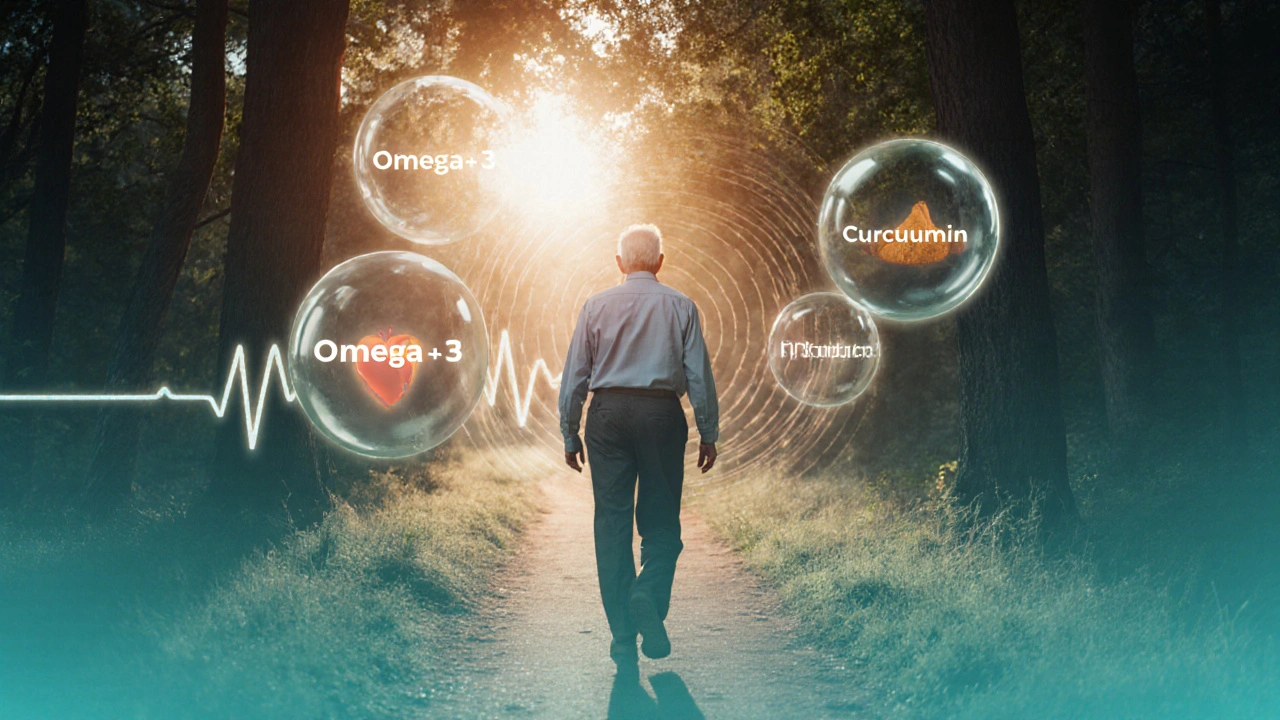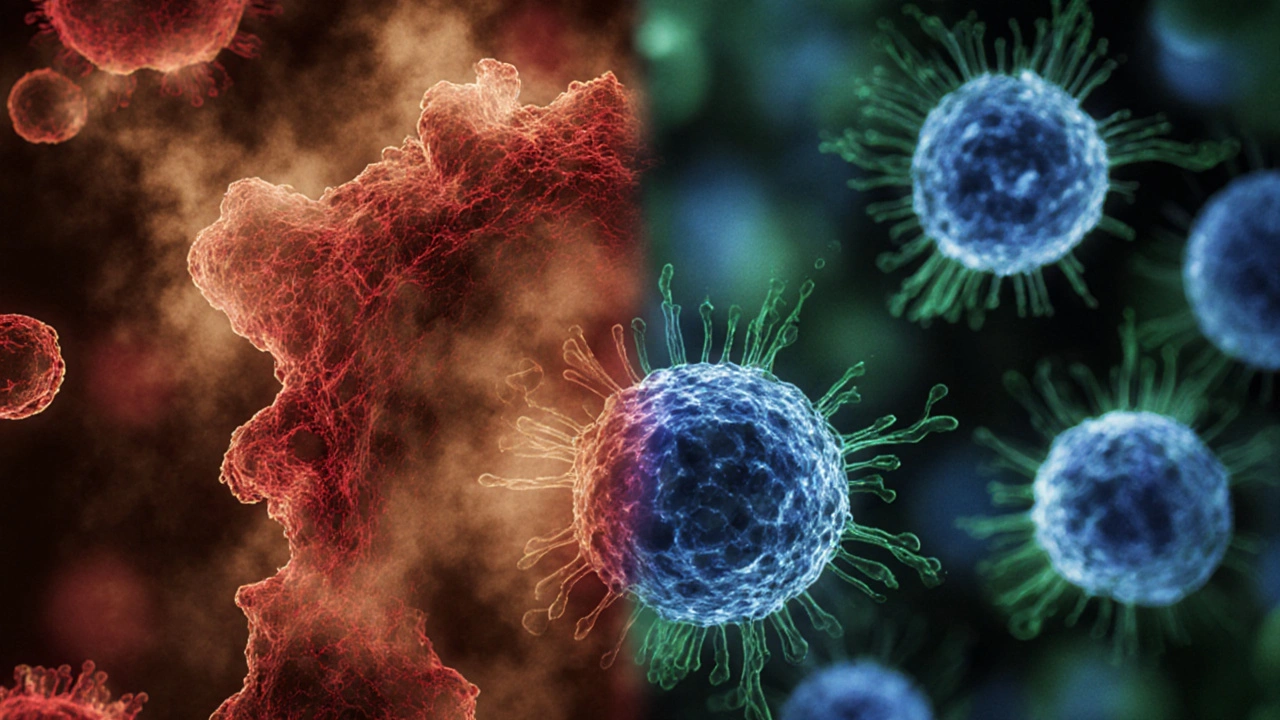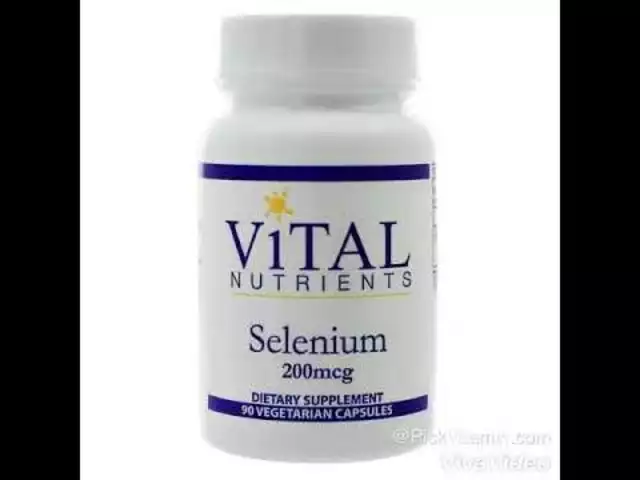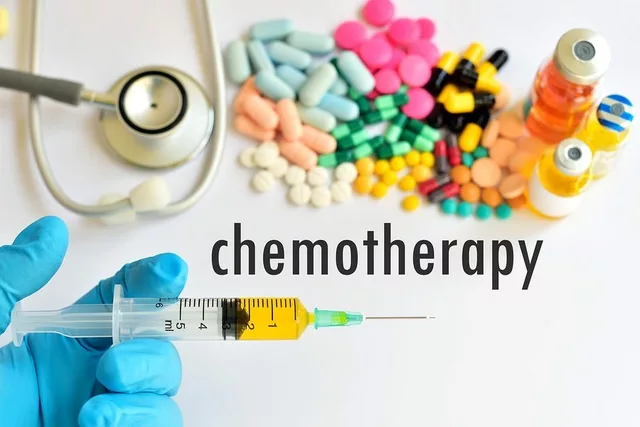Anti-Inflammatory Lifestyle Calculator
Assess Your Inflammation Risk
Answer the following questions about your lifestyle to calculate your inflammation risk score and receive personalized recommendations.
Your Inflammation Risk Assessment
When you hear the word "inflammation," you might picture a swollen ankle or a painful tooth. But low‑grade inflammation is also quietly ticking away inside your cells, nudging you toward the aches and chronic illnesses that come with getting older. Understanding why inflammation and aging are two sides of the same coin can give you a clear set of actions to keep the fire low and live a fuller, healthier life.
Key Takeaways
- Inflammation is a natural immune response, but chronic, low‑grade inflammation accelerates aging.
- Key drivers include cytokine spikes, oxidative stress, gut imbalance, and sedentary habits.
- Eating a Mediterranean‑style diet, moving regularly, prioritising sleep, and managing stress can reduce inflammation significantly.
- Targeted supplements such as omega‑3s, curcumin, and antioxidants support the body’s anti‑inflammatory pathways.
- Small, consistent changes beat drastic, short‑term fixes for long‑term health.
What Is Inflammation and Why Does It Matter With Age?
Inflammation is a biological response of the immune system that aims to eliminate harmful stimuli, such as pathogens or damaged cells. It involves the release of signaling proteins called cytokines and the activation of white blood cells. While acute inflammation heals injuries, a persistent, low‑grade state-sometimes called "inflammaging"-creates a toxic environment that accelerates cellular damage.
As we grow older, the immune system becomes less efficient at distinguishing danger from normal wear‑and‑tear. This shift leads to a chronic release of pro‑inflammatory cytokines like IL‑6 and TNF‑α, which in turn damage tissues, shorten telomeres, and promote age‑related diseases such as heart disease, diabetes, and Alzheimer’s.

Aging and Inflammation: The Biological Link
Aging is the gradual decline in physiological function over time, driven by genetic, environmental, and lifestyle factors. One hallmark of aging is the accumulation of senescent cells-cells that no longer divide but secrete a cocktail of inflammatory molecules, known as the senescence‑associated secretory phenotype (SASP).
Another key player is Oxidative stress, which occurs when reactive oxygen species (ROS) overwhelm the body’s antioxidant defenses. ROS damage DNA, proteins, and lipids, triggering more inflammation and speeding up the aging clock.
The Gut microbiome also influences the inflammation‑aging axis. An imbalance-often called dysbiosis-lets lipopolysaccharides (LPS) leak into the bloodstream, igniting systemic inflammation that harms distant organs.
How Lifestyle Choices Influence Inflammation
Good news: unlike genetics, lifestyle factors are largely within your control. Below are the most evidence‑backed habits that blunt inflammation and support graceful aging.
Eat an Anti‑Inflammatory Diet
Foods rich in polyphenols, omega‑3 fatty acids, and fiber tamp down cytokine production. The Mediterranean diet-characterised by olive oil, nuts, leafy greens, fatty fish, and moderate wine-has repeatedly shown lower IL‑6 and CRP levels in older adults.
Here’s a quick visual of top anti‑inflammatory foods and what they bring to the table:
| Food | Key Anti‑Inflammatory Compounds | Typical Serving | Impact on Biomarkers |
|---|---|---|---|
| Fatty fish (salmon, mackerel) | EPA/DHA (omega‑3) | 100g | ↓ CRP by 15‑20% |
| Extra‑virgin olive oil | Oleocanthal, polyphenols | 2tbsp | ↓ IL‑6 by 10% |
| Berries (blueberries, strawberries) | Anthocyanins | ½cup | ↓ oxidative markers |
| Turmeric (curcumin) | Curcumin | ½tsp powder | ↓ TNF‑α by 12% |
| Leafy greens (kale, spinach) | Carotenoids, flavonoids | 1cup cooked | ↑ antioxidant capacity |
Move Your Body Regularly
Exercise-both aerobic and resistance training-lowers systemic inflammation by reducing visceral fat, enhancing muscle insulin sensitivity, and stimulating the release of anti‑inflammatory cytokines such as IL‑10.
Aim for at least 150minutes of moderate cardio (brisk walking, cycling) plus two strength sessions per week. Even short bouts of high‑intensity interval training (HIIT) three times a month can slash CRP levels dramatically.
Prioritise Quality Sleep
Sleep deprivation spikes cortisol and IL‑6, paving the way for chronic inflammation. Most adults need 7‑9hours of uninterrupted sleep. Practical tips: dim lights an hour before bed, keep the bedroom cool, and avoid caffeine after 2p.m.
Manage Stress Effectively
Psychological stress activates the sympathetic nervous system, releasing norepinephrine that triggers inflammatory pathways. Mind‑body practices-meditation, deep‑breathing, yoga-have been shown to cut CRP by up to 30% in older participants.
Targeted Supplements
When diet alone falls short, certain supplements can plug the gaps.
- Omega‑3 fatty acids (EPA/DHA) - 1‑2g daily reduces triglycerides and inflammatory markers.
- Curcumin (standardised to 95% curcuminoids) - 500mg with black‑pepper extract improves bioavailability and lowers TNF‑α.
- Vitamin D3 - 1000‑2000IU supports immune regulation; deficiency is linked to higher CRP.
- Probiotics (Lactobacillusrhamnosus, Bifidobacteriumlongum) - restore gut balance, limiting LPS leakage.
Putting It All Together: A Simple 7‑Day Action Plan
- Morning: 10minutes of gentle stretching or yoga, followed by a smoothie with spinach, berries, chia seeds, and a splash of oat milk.
- Mid‑day: Choose a Mediterranean lunch-grilled salmon, quinoa, mixed vegetables, and a drizzle of olive oil.
- Afternoon: Take a brisk 20‑minute walk after lunch. If you’re at a desk, stand up and move every hour.
- Evening: Wind down with a screen‑free hour, practice deep‑breathing, and aim for 7‑8hours of sleep.
- Supplements: On an empty stomach, take omega‑3 (1g) and curcumin (500mg) with a glass of water.
- Weekend: Swap one meal for a plant‑based plate-lentils, roasted veggies, and a side of fermented kimchi.
- Reflection: Keep a simple log of meals, activity, and how you feel. Small patterns reveal big changes.
Stick with this routine for three weeks, then adjust portions or add new anti‑inflammatory foods. Consistency beats perfection every time.

Common Pitfalls and How to Avoid Them
- Relying on “miracle” supplements. Whole foods deliver a synergistic blend of nutrients; use supplements only to fill gaps.
- Skipping breakfast. An early nutrient‑dense meal stabilises blood sugar and curbs cortisol spikes.
- Ignoring hidden sugars. Processed snacks raise insulin and CRP even if they’re marketed as “low‑fat.”
- Overtraining. Excessive high‑intensity work without recovery can actually raise inflammation. Listen to your body.
Long‑Term Outlook: How Reducing Inflammation Extends Healthy Years
Research from the Longevity Institute (2024) shows that individuals who maintain CRP levels below 2mg/L enjoy a 15‑20% lower risk of age‑related chronic disease over a 10‑year span. Lower inflammation also preserves muscle mass, supports cognitive function, and keeps the cardiovascular system elastic.
In short, by tackling the root causes of chronic inflammation, you’re not just adding years to your life-you’re adding life to those years.
Frequently Asked Questions
What exactly is "inflammaging"?
Inflammaging is a term that describes the chronic, low‑grade inflammation that builds up as we age. It’s driven by persistent cytokine release, oxidative stress, and gut‑derived toxins, all of which accelerate cellular aging and disease risk.
Can I reverse inflammation once it’s chronic?
You can’t erase decades of damage instantly, but you can dramatically lower ongoing inflammation through diet, movement, sleep, stress control, and targeted supplements. Most people see measurable improvements in blood markers within 8-12 weeks.
How often should I test my inflammation levels?
A simple high‑sensitivity C‑reactive protein (hs‑CRP) test every 6‑12months is enough for most healthy adults. If you have chronic conditions, discuss more frequent monitoring with your clinician.
Are there any foods I should avoid to keep inflammation low?
Yes. Highly processed carbs, trans fats, excessive red meat, and sugary beverages all trigger spikes in IL‑6 and CRP. Swap them for whole grains, plant proteins, and healthy fats.
Does coffee increase inflammation?
Moderate coffee (2‑3 cups daily) actually contains antioxidants that can lower inflammation. Problems arise when you add sugar, cream, or consume it late in the day, disrupting sleep.






leo calzoni
October 5, 2025 AT 14:03Stop reading these pseudo‑science articles and think for a second, inflammation isn’t some mystical curse you can cure with a smoothie. Your body’s immune system is complex and you can’t just fix it with a handful of berries. Get a real education before spouting nonsense.
KaCee Weber
October 5, 2025 AT 15:13Wow, this guide really hits the nail on the head when it comes to making our everyday choices matter for long‑term health 😊. It starts by reminding us that inflammation is not just a medical term but a daily reality that we can influence with simple habits. First, loading up on leafy greens, berries, and fatty fish gives us polyphenols and omega‑3s that calm the immune system. Second, moving our bodies even a little each day shatters the buildup of visceral fat that fuels inflammatory cytokines. Third, getting solid sleep resets cortisol levels and lets the body repair damaged cells while we dream. Fourth, managing stress with meditation, deep breathing, or a favorite hobby reduces the sympathetic surge that spikes IL‑6. I also love the tip about swapping sugary drinks for water flavored with lemon – it’s a tiny tweak with a big payoff. The calculator idea is clever because it turns abstract scores into concrete actions we can track. In practice, I’ve started a habit of a 10‑minute sunrise stretch, followed by a berry‑rich smoothie, and I can already feel less sluggish. The article also wisely warns against “miracle” supplements and suggests focusing on whole foods first, which keeps us grounded. Adding a probiotic now and then is a nice safety net for gut health, and the suggested doses are realistic. It’s refreshing to see a balanced perspective that celebrates progress rather than demanding perfection. Finally, the 7‑day action plan feels doable without overwhelming anyone, and the suggestion to log feelings helps fine‑tune the routine. If you keep this momentum, the cumulative effect on your CRP levels could be impressive 🌟. Keep sharing these practical steps, because the more we spread them, the more people can lower their inflammation and age gracefully.
jess belcher
October 5, 2025 AT 16:36The article outlines how diet, exercise, sleep, and stress management each affect inflammation and suggests practical steps for improvement.
Sriram K
October 5, 2025 AT 18:00I totally agree with the emphasis on balanced nutrition and regular movement. From my experience, adding a daily 15‑minute walk after lunch makes a noticeable difference in joint stiffness. Also, prioritizing a consistent bedtime helps regulate cortisol, which in turn lowers chronic inflammation. If you struggle with sleep, try limiting screens an hour before bed and consider a warm herbal tea. For stress, simple breathing exercises for five minutes can reset the nervous system. Remember, small sustainable changes beat drastic diets any day.
Deborah Summerfelt
October 5, 2025 AT 19:23Honestly, all this hype about “inflammaging” feels like a marketing gimmick to sell supplements. Sure, diet and exercise matter, but the body’s inflammation pathways are way more complicated than a checklist. You can’t just blame every ache on a high CRP level.
Maud Pauwels
October 5, 2025 AT 20:46I hear you and understand the concern but the evidence linking lifestyle to inflammation is solid and many studies support these recommendations.
Scott Richardson
October 5, 2025 AT 22:10What’s wrong with our country is that we ignore simple common‑sense health habits while glorifying fast food and lazy lifestyles. We need to stand up and demand better nutrition standards for everyone.
Laurie Princiotto
October 5, 2025 AT 23:33All that talk about “miracle foods” is just hype 😒.
Justin Atkins
October 6, 2025 AT 00:56Allow me to elucidate the physiological rationale underlying the propositions delineated herein. The cascade of pro‑inflammatory cytokines, notably interleukin‑6 and tumor necrosis factor‑α, constitutes a veritable tempest within the vascular milieu, fomenting endothelial dysfunction and atherogenesis. By augmenting the intake of omega‑3 fatty acids, one attenuates the eicosanoid synthesis pathway, thereby mitigating the inflammatory surge. Concurrently, judiciously calibrated aerobic exertion engenders an upregulation of anti‑inflammatory adipokines such as adiponectin. Moreover, the circadian orchestration of melatonin during restorative sleep curtails oxidative stress, an ancillary catalyst of cellular senescence. Thus, the integrative regimen advocated by the author is undergirded by a confluence of mechanistic evidence.
June Wx
October 6, 2025 AT 02:20Totally, just swap the soda for water and add a handful of nuts – it’s that easy.
kristina b
October 6, 2025 AT 03:43In the grand tapestry of human existence, the relentless march of time is inexorably entwined with the subtle fire of inflammation that smolders within our very cells. One might contemplate whether the corporeal vessel is simply a passive receptacle or an active participant in a dialogue with the environment, wherein each morsel consumed and each breath taken reverberates through the molecular symphony of cytokines and antioxidants. The ancient philosophers posited that balance, or “mesotes,” is the virtue that sustains the soul; analogously, modern science reveals that equilibrium between pro‑ and anti‑inflammatory forces preserves the integrity of the organism. When we indulge in processed comestibles replete with refined sugars and trans fats, we tip this balance towards a chronic, low‑grade inflammatory state, often termed “inflammaging,” which inexorably accelerates senescence. Conversely, the deliberate incorporation of polyphenol‑rich berries, omega‑laden fish, and verdant leafy greens can be viewed as a form of alchemical transmutation, converting potential discord into harmonious resilience. Likewise, the kinetic act of locomotion-whether a brisk promenade or a vigorous interval session-serves not merely as caloric expenditure but as a catalyst for the release of myokines, endogenous agents that whisper anti‑inflammatory counsel to the immune system. Sleep, that nightly pilgrimage of the mind, orchestrates the secretion of growth hormone and the clearance of metabolic waste via the glymphatic pathway, thereby averting the accrual of oxidative debris that would otherwise inflame cellular structures. Stress, the insidious tempest of modernity, summons catecholamines that amplify inflammatory cascades, yet through mindfulness and contemplative praxis we can cultivate an inner citadel of tranquility, dampening the sympathetic surge. It is incumbent upon each individual to heed the empirical counsel, to curate a lifestyle that honors the delicate interplay of these variables, for in doing so one does not merely postpone the ravages of time but actively enriches the tapestry of lived experience. Thus, the pursuit of an anti‑inflammatory existence is not merely a regimen but a philosophical commitment to the art of balanced living, a testament to the profound agency we possess over the biological narrative of our own mortality.
Ida Sakina
October 6, 2025 AT 05:06From a moral standpoint, we are obligated to steward our bodies with reverence, for neglecting the evident pathways of inflammation constitutes a dereliction of duty to oneself and to society. The scriptures of health decree that indulgence in deleterious foods is a transgression against the natural order.
Amreesh Tyagi
October 6, 2025 AT 06:30Maybe it’s just aging, not inflammation.
Brianna Valido
October 6, 2025 AT 07:53Great job on taking the first steps 😊 keep it up and the benefits will follow!
Caitlin Downing
October 6, 2025 AT 09:16Hey there! I love how you break down the science into easy‑to‑follow tips – it’s like a recipe for a healthier you. The way you described adding a splash of olive oil or a handful of berries feels super achievable. Keep sharing this kind of info, it really helps people who might feel ovrwhelmed by all the health jargon out there.
Robert Jaskowiak
October 6, 2025 AT 10:40Oh sure, because everyone has time to log every bite and count minutes of sleep, right? 🙄
Julia Gonchar
October 6, 2025 AT 12:03Just so you know, high‑sensitivity CRP tests are the gold standard for measuring systemic inflammation and should be done every six months if you’re following this plan.
Annie Crumbaugh
October 6, 2025 AT 13:26This looks useful.